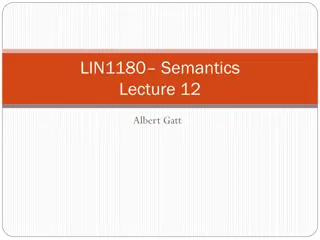Understanding the Past Perfect Tense in English Grammar
The Past Perfect Tense is used to talk about actions completed before a certain point in the past, emphasizing the sequence of events. This tense follows the structure of "had + past participle" and is crucial for expressing events that happened earlier than others in a narrative. Knowing how to form and use the Past Perfect Tense enables clearer and more specific communication.
Download Presentation

Please find below an Image/Link to download the presentation.
The content on the website is provided AS IS for your information and personal use only. It may not be sold, licensed, or shared on other websites without obtaining consent from the author. Download presentation by click this link. If you encounter any issues during the download, it is possible that the publisher has removed the file from their server.
E N D
Presentation Transcript
English Course ASSIT. LECT. NOOR HASAN RADHI
This lecture Grammar: Past Perfect Tense. Vocabulary Adjectives. Writing Punctuation Marks . New idiom.
Past Perfect It is used to talk about actions that were completed before some point in the past, talking about something that happened before something else. The past perfect formula The formula for the past perfect tense is had + [past participle]. It doesn t matter if the subject is singular or plural; the formula doesn t change.
How do we make the Past Perfect tense? The structure of the Past Perfect tense is: subject + auxiliary have + main verb conjugated in Past Simple had past participle
For negative sentences we insert not between the auxiliary verb and the main verb. For question sentences, we exchange the subject and the auxiliary verb. Look at these example sentences with the Past Perfect tense:
subject auxiliary verb main verb + I had finished my work. + You had stopped before me. - She had not gone to school. - We had not left. ? Had you arrived? ? Had they eaten dinner?
When to use the past perfect So what s the difference between past perfect and simple past? When you re talking about some point in the past and want to reference an event that happened even earlier, using the past perfect allows you to convey the sequence of the events. It s also clearer and more specific. The train left at 9am. We arrived at 9:15am. When we arrived, the train had left.
The train had left when we arrived. past present Train left in past at 9:00 future 9:00 We arrived in past at 9:15 9:15 Another example: "Mary wasn't at home when I arrived." / "Really? Where had she gone?"
Another time to use the past perfect is when you are expressing a condition and a result: If I had woken up earlier this morning, I would have caught Tootles red- handed. The past perfect is used in the part of the sentence that explains the condition (the if-clause). Most often, the reason to write a verb in the past perfect tense is to show that it happened before other actions in the same sentence that are described by verbs in the simple past tense. Writing an entire paragraph with every verb in the past perfect tense is unusual.
We often use the Past Perfect in reported speech after verbs like: said, told, asked, thought, wondered Look at these examples: He told us that the train had left. I thought I had met her before, but I was wrong. He explained that he had closed the window because of the rain. I wondered if I had been there before. I asked them why they had not finished.
Adjectives : Very tasty Delicious Very fast Rapid Very pretty Gorgeous Very calm Tranquil Very happy Thrilled Very hard Difficult Very hard to find Rare Very heavy Leaden Very hungry Starving
Very afraid Fearful Very angry Furious Very bad Awful Very big Massive Very high Soaring Very hurt Battered Very boring Dull Very necessary Essential Very old Ancient Very nervous Apprehensive Very tired Exhausted Very busy Swamped
Writing Punctuation marks
Punctuation can make an enormous difference in the meaning of whatever it is you re writing. Consider the following classic examples of the change in meaning that punctuation can communicate: Let s eat, Grandma! Woman, without her man, is nothing. Let s eat Grandma! Woman! Without her, man is nothing.
Lets face it: proper punctuation can make or break the impact of an otherwise well-constructed sentence. These basic rules can strengthen your sentences with the punctuation they deserve, so that the quality of your ideas is communicated with clarity.
Commas Commas indicate a separation of ideas or elements within the structure of a sentence. For more information on comma usage
Todays idiom. And Vice Versa























